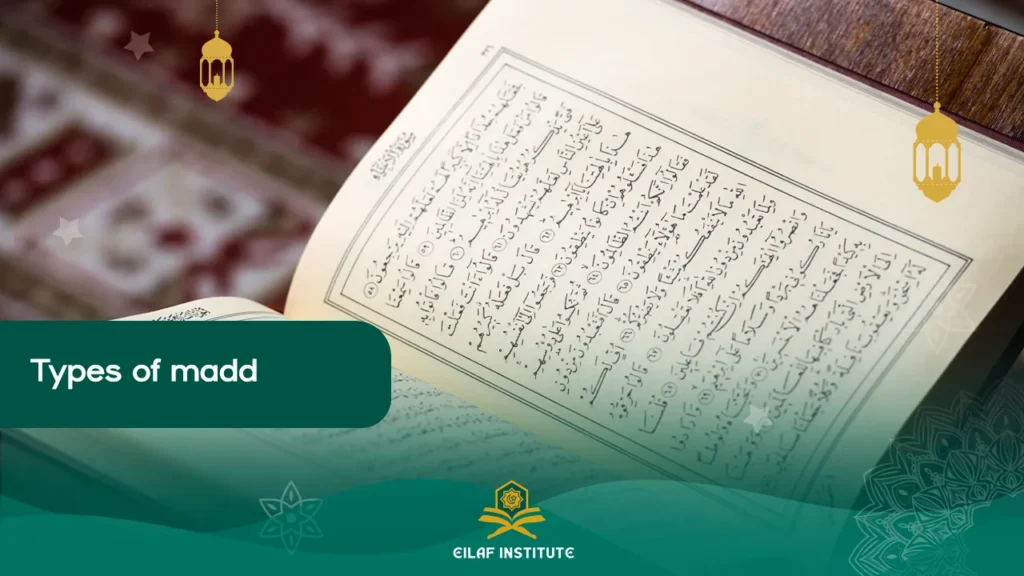Grasping the Types of Madd is key for anyone aiming to recite the Quran correctly and melodiously. It is one of the most essential tajweed (intonation) rules that deeply influences the beauty and accuracy of Quranic recitation. A clear understanding of the Types of Madd is foundational for any student of the Quran.
In this article, we’ll delve into the concept of Madd, break down its various types of madd with examples, and illustrate each with clear examples from the Holy Quran, making this vital rule and all Types of Madd easier to understand, remember, and apply.
What are the types of Madd?
We are going to discuss the fundamental Types of Madd. Essentially, the Types of Madd are divided into two main categories, which we will explore in detail.
1. Madd Asli (Primary Madd)
The first of the primary Types of Madd is Madd Asli (Primary Madd). In Arabic, this is the inherent, natural type of Madd and is found inherently in the words.
It occurs when a letter of elongation (madd letters) is followed by neither a hamzah (ء) nor a sukoon (ْ). The elongation is natural and limited to two counts (beats). You will find many examples of madd asli in quran.
Examples of madd asli letters:
- Alif (ا) preceded by a letter with a fatḥah ( َ ).
- Waw (و) preceded by a letter with a dammah ( ُ ).
- Yaa (ي) preceded by a letter with a kasrah ( ِ ).
2. Madd Far’i (Secondary prolongation)
The second major category of the Types of Madd is Madd Faree (secondary madd). Madd Far‘i is an extension that exceeds the natural length of Madd Asli (two counts) due to specific conditions, such as the presence of a hamzah (ء) or sukoon ( ْ ). Below are the Types of Madd that fall under Madd Far‘i and their examples:
A. Madd Muttasil (Connected Prolongation)
This is a key sub-type within the Types of Madd. Madd Muttasil occurs when a hamzah (ء) follows a madd letter in the same word. It is prolonged for 4 to 5 counts.
- Example:
- جَاءَ (Jaa’a) – Surah An-Naba (78:19)
- سِيئَآتْ (Say’aat) – Surah Az-Zumar (39:60)
B. Madd Munfasil (Separated Prolongation)
Another important one of the Types of Madd is Madd Munfasil. It occurs when a madd letter is at the end of one word, and a hamzah begins the next word. It is prolonged for 4 to 5 counts.
- Madd Munfasil Examples:
- يآ أَيُّهَا (Yaa Ayyuha) – Surah Al-Baqarah (2:21)
- فِي أَنْفُسِكُمْ (Fee Anfusikum) – Surah Aal-E-Imran (3:30)
C. Madd Laazim (Obligatory Prolongation)
This is one of the longest and most significant Types of Madd. It occurs when a madd letter is followed by a sukoon (ْ) in the same word or after a shaddah (shaddah indicates a doubled letter). It is prolonged for 6 counts.
- Example:
- الْحَاقَّةُ (Al-Haaqqah) – Surah Al-Haqqah (69:1)
- وَلَا الضَّالِّينَ (Wala Ad-Daalleen) – Surah Al-Fatihah (1:7)
Read also about Tajweed Rules
D. Madd ‘Aridh Lis-Sukoon (Temporary Prolongation)
This temporary elongation is a common example among the different Types of Madd. It occurs when a madd letter is followed by a temporary sukoon at the end of a verse or pause during recitation. It is prolonged for 2, 4, or 6 counts.
- Example:
- الْعَالَمِينَ (Al-‘Aalameen) – Surah Al-Fatihah (1:2)
- نَسْتَعِينُ (Nasta’een) – Surah Al-Fatihah (1:5)
F. Madd Badal (Substitution Prolongation)
Occurs when a hamzah precedes a madd letter. It is prolonged for 2 counts, similar to Madd Asli.
- Example:
- آمَنُوا (Aamanu) – Surah Al-Baqarah (2:2)
- إِيمَانًا (Eemana) – Surah Al-A’raf (7:26)
G. Madd Lin (Soft Prolongation)
Occurs when a letter of lin (و or ي with a preceding fatḥah) is followed by a temporary sukoon. It is prolonged for 2, 4, or 6 counts.
- Example:
- خَوْفٍ (Khawf) – Surah Quraysh (106:4)
- بَيْتٍ (Bayt) – Surah Quraysh (106:3)
Types of madd in tajweed
In Tajweed, understanding the Types of Madd (elongation) refers to the lengthening of a vowel sound. The proper application of Madd is essential for accurate Quranic recitation.
There are two main categories for the Types of Madd: Madd Al-Asli (natural Madd) and Madd Faree (subsidiary or secondary Madd). Here’s a breakdown of each:
1. Madd Al-Asli (Natural Madd)
Madd Al-Asli refers to the natural elongation of a vowel sound, which occurs without any special conditions or circumstances. There are three main types of Madd Al-Asli:
a. Madd Muttasil (Connected Madd)
- Definition: This occurs when a Madd vowel (like Alif, Waw, or Ya) is followed by a Hamzah (ء) in the same word.
- Length: It is elongated for 4 to 5 counts.
- Example:
- رَحْمَةٌ (Rahmatun) – The “a” in “Raḥma” is elongated due to the following Hamzah.
- فَأَمَّا (Faammā) – The “a” is elongated due to the Hamzah.
b. Madd Munfasil (Separated Madd)
- Definition: This occurs when a Madd vowel is followed by a Hamzah in the next word, meaning that the Hamzah is not in the same word as the Madd vowel.
- Length: It is elongated for 4 to 5 counts.
- Example:
- وَأَمَّا (Waammā) – The “a” in “Wa” is elongated due to the following Hamzah in the next word.
c. Madd Laazim (Necessary Madd)
- Definition: This occurs when a Shaddah (ـّ) is followed by a Madd vowel (Alif, Waw, or Ya) in the same word.
- Length: This is elongated for 6 counts.
- Example:
- الْحَمْدُ (Al-ḥamdu) – The “a” sound is elongated because of the Shaddah and Madd vowel.
2. Madd Faree (Subsidiary or Secondary Madd)
Madd Faree refers to elongation that occurs due to specific conditions or rules in recitation. These types of Madd are not naturally occurring but are the result of certain letters or situations.
a. Madd ‘Aridh Lissukoon (Temporary Madd)
- Definition: This occurs when a Madd vowel (Alif, Waw, or Ya) is followed by a sukoon (ــْ) in the same word, and it happens at the end of the word (causing a temporary pause).
- Length: It is elongated for 2 to 4 counts (depending on the recitation style).
- Example:
- فَصَارُوا (Fasārū) – The “a” sound is elongated because it is followed by sukoon.
b. Madd Badal (Substitute Madd)
- Definition: This occurs when a Hamzah is preceded by a Madd vowel in the same word.
- Length: It is elongated for 2 counts.
- Example:
- قَائِلٌ (Qā’ilun) – The “a” in “Qā” is elongated due to the following Hamzah.
c. Madd Silah (Linking Madd)
- Definition: This occurs when a Ya with a sukoon is followed by a word starting with a Hamzah. The sound of Ya is lengthened in the linking process.
- Length: It is elongated for 2 counts.
- Example:
- يَأْتِي (Yā’tī) – The “Ya” is elongated when the Hamzah follows it.
d. Madd Qawī (Strong Madd)
- Definition: This is a general term for when the elongation is strong due to specific circumstances.
- Length: It can be up to 6 counts, particularly in cases of Madd Laazim.
- Example:
- الْحَاقَّةُ (Al-ḥāqqah) – The “a” sound is elongated due to the presence of a Shaddah and Madd vowel.
Each of these Types of Madd plays a crucial role in ensuring that the Quran is recited properly, with correct pronunciation and rhythm.
Practicing with a teacher who understands these rules can help you master all Types of Madd and improve your Quranic recitation.
Enroll in our online class, Learn Quran Recitation with Tajweed. In this course, we will help you recite the Quran with Tajweed rules through one-on-one personalized online sessions.
Source:
Rulings of al-Madd in Qur’aan recitation

